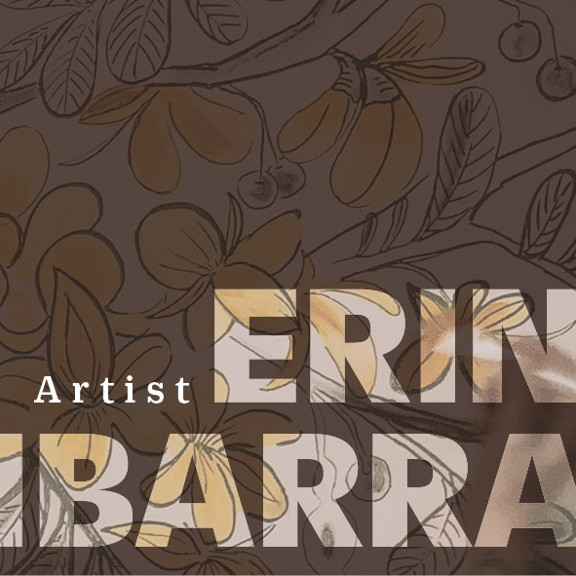言語を選択
通貨を選択

地元のアーティストがハワイの花に命を吹き込む
We sat down with muralist Erin Ibarra, one of the select artists who are forming the spaces at the new OUTRIGGER Waikiki Beachcomber Hotel. Erin is well-known in the community for her work with local businesses and her fiery passion for creating learning opportunities through art. Ibarra's work features a different plant species endemic to Hawaii on each floor of the resort; that's 24 different pieces all together. See what she has to say about it:
Q:アートをビジネスとして始めるようになったきっかけは?これは計画していたことだったのですか?
A: いいえ、全くありません。私はレストランとサービス業界に本当に情熱を持っていました。クラフトビールのシーンと黒板は、私が数年前に始めた頃からますます人気が出ていました。これらの黒板を本当に楽しい方法で装飾する本当にクールな機会がたくさんありました - 人々は私の手書きとそれに伴う芸術的なスタイルをとても気に入っていました - だから私は実際の仕事の代わりに仕事に来てそれをしました。そして(笑いながら)、その時、私はウェイトレスよりも優れたアーティストかもしれないと気づいたのです。
Q:このタイプのアートがあなたのものになると気づいたのはいつですか?
A: これを成し遂げられると実感したのは、(ホノルルのパブが)オープンしたときでした。そこにいた常連客は、私がすでに知っていた人々でした。ビール、サービス、そしてビジネス全般における真のクラフトに対するニーズ、欲求がありました。彼らは私の小さな黒板の作品を見て、私が彼らのものをやるだろうと思い、8×4フィートの巨大な黒板を自分たちで作ったのです。そのプロジェクトが終わったとき、すぐに「これはすごい。これは私が今まで経験した中で最も楽しいもので、誰もが自分のビジネスのためにこのようなものを必要としています。」それは私にとって、大好きな業界で生活し、働くための素晴らしい方法でしたが、今ではアートも含めて、完璧な組み合わせでした。今では、明らかにさまざまな道に成長しています。
Q:あなたはよく、誰かやより大きなグループにサービスをもたらすという自分のアートについて話します。それについて詳しく教えていただけますか?
A: ニッチなタイプのアート、つまりアート情報の注入を提供できるのが大好きです。それは芸術のための芸術だけではありません。それは物語を語ります。それは何かを教えてくれます。これは、ウェイファインディングツールとして機能します。
Q:手書きのスタイルから、ここでの大きな花の作品にどのように移行しましたか?
A: それは 100、私がやってきたことの自然な進化でした。例えば、私が食べ物のために描いたイラストの多くは、純粋に有機的なものでした。それはただのものだったが、それはとても大きな意味を持っていた。私はポークボウルの地元の魚を説明する課題を持っていました。在来種、食べ物、小さな生き物を描く機会のすべては、私が本当にうまく得たものです。それは超自然的で、リアルで、ヴィンテージのスタイルです。私はいつも、昔ながらの科学書風のイラストが大好きです。
Q: あなたの手書きのイラストは、アーティストがステンシルと考えるものと整列している、または似ていると思いますか?
A: 私が手がけている多くのプロジェクトには、ステンシルの要素があります。しかし、私が行うプロジェクトのかなりの 75%は、壁に描くだけです。プロジェクトのリクエストが全部わかったら、自分のレベルを持って臨み、なんとなく理解していきます。デザインについて多くの人々の同意を得るために、より多くの先見の明が必要な他のプロジェクトでは、いくつかのフェーズとデザインモックアップが最初に来ます。
Q:ワイキキビーチコマーでの花の仕事は、どのようなプロセスでしたか?
A: この特定のプロジェクトは、私がプロジェクターを使用するのが好きなプロジェクトの 25% 以内に収まります。タトゥーアーティストのように考えてみてください。一部のアーティストは自分の快適ゾーンを知っており、すべてが自分の主題にどのように適合するかを知っています。しかし、それが新しい種類のプロジェクト、大きな作品である場合、彼らは通常、主題にステンシルを塗り、いくつかの修正を行い、消去、サイズ変更、再ステンシルなどを行う必要があります。それは、あなたのアートを最終的にあなたが望むとおりに見せるための全プロセスです。プロジェクターは、このような自由なキャンバスのように見える白い壁でスケールを見失いたくない場合に、このようなプロジェクトに役立ちます。つまり、大きくなることを恐れていないのです。
Q:そして、ここワイキキビーチコーマーのピースは天井まで上がります!そんな強いビジョンを持つことが、あなたの大きな強みの一つだと感じていますか?
A: もちろんです。レイアウトのビジョン。そして、先ほども言ったように、私は大きくなることを恐れていません。実際、大きければ大きいほど良いのです。これがとても協力的なプロジェクトだったのは助かります。アイデアを提示されたとき、私たちの元のコンセプトは少し単純すぎると思ったので、いくつかの提案をしたところ、ほとんどのプロジェクトがそうであるように、ほとんど一人で命を吹き込まれました。少しずつ、ピースがまとまっていきます。例えば、花を床ごとに整理し、最終的には自然な高さで見つけることができる場所によって作品を配置する方法などです。それは「なるほど!」という瞬間でした。それはとても有機的で、しっく りきます 。
Q:花について詳しく教えていただけますか?このプロジェクトでは、多くの調査を行いました。
A: もちろんです!私はここハワイの固有種を強調したいと思っていました。それらのいくつかは先住民と見なされますが、コレクション全体が固有種です。地元の影響を受けたアートを長年手がけてきた中で、ハイビスカスやプルメリアのリクエストをたくさんもらってきましたが、これはあまりスポットライトを浴びない種にもっと愛情と注意を向ける機会です。それは間違いなく教育の機会です。ゲストが滞在の終わりに来たときに、マイレ植物のようなものが何であるかを知り、家に帰ったときにハワイについてのあまり知られていない事実のいくつかを共有できるようになることを願っています。
Q: 現在取り組んでいる作品について少し教えていただけますか?
A: ええ、特別なものです!まあ、それらはすべて宝石です。この植物は、 ビッグアイランドの荒涼とした黒い溶岩原から生えている、大きくて真っ赤なベリーです。その島に行って、スラットの黒い溶岩のフィールドを見ると、これらの注目を集める明るいベリーがすぐそこに芽を出します。実際、それは正気の沙汰ではないと思うし、そういう小さなことが大好きです。プロジェクト全体は、明らかに私にとって非常にエキサイティングで個人的なものでした。他の人がこれらの植物について別のレベルで学び始めることができることを願っています。
Q: あなたのエネルギーと興奮は、間違いなく作品に反映されています。あなたの個人的なお気に入りはどの植物ですか?
A: ああ、いい質問だね。それはナウパカと呼ばれています。最近、ナウパカには実は2つの種族がいることを知りました。1つはビーチのナウパカで、もう1つは山のナウパカです。伝説によると、別れた恋人同士がいたとされていますが、これらの花は彼らがお互いに持っていた愛を表しています。浜辺のナウパカは花びらの半分しか生えず、花びらは下を向いています。山に生えるものも花びらの半分しか生えませんが、上を向いて成長します。どちらも完全な花を育てることはありません。
Q:プロセスの中で一番好きな部分は?
A: 初めて壁に乗り始めたとき。それは、頭の中にあった小さなものを、最終的な大きなキャンバスに移すという考え方です。真っ白な壁のビジョンが、空間全体を一変させるのを見るのは、とてもエキサイティングです。
Q:最後の質問です。このプロジェクトを通じて、あなたは何を感じていますか?
A: まず、光栄です。この場所のリブランディングの一部になるために、ここにはまさに素晴らしいエネルギーが溢れています。その純粋さが信じられないほど感じます。自分が所属していると感じ、この空間の変革に貢献するプレーヤーになること。私の仕事を愛し、彼らがどこに向かっているのかを愛する会社と一緒に働くことは、非現実的です。そのフィット感は本当に珍しい発見です。私たち全員がハワイ、アイナ、さらにはホテルの文化とより深くつながるチャンスでした。
Book your next stay with the OUTRIGGER Waikiki Beachcomber Hotel and find out what flora will be on your floor!